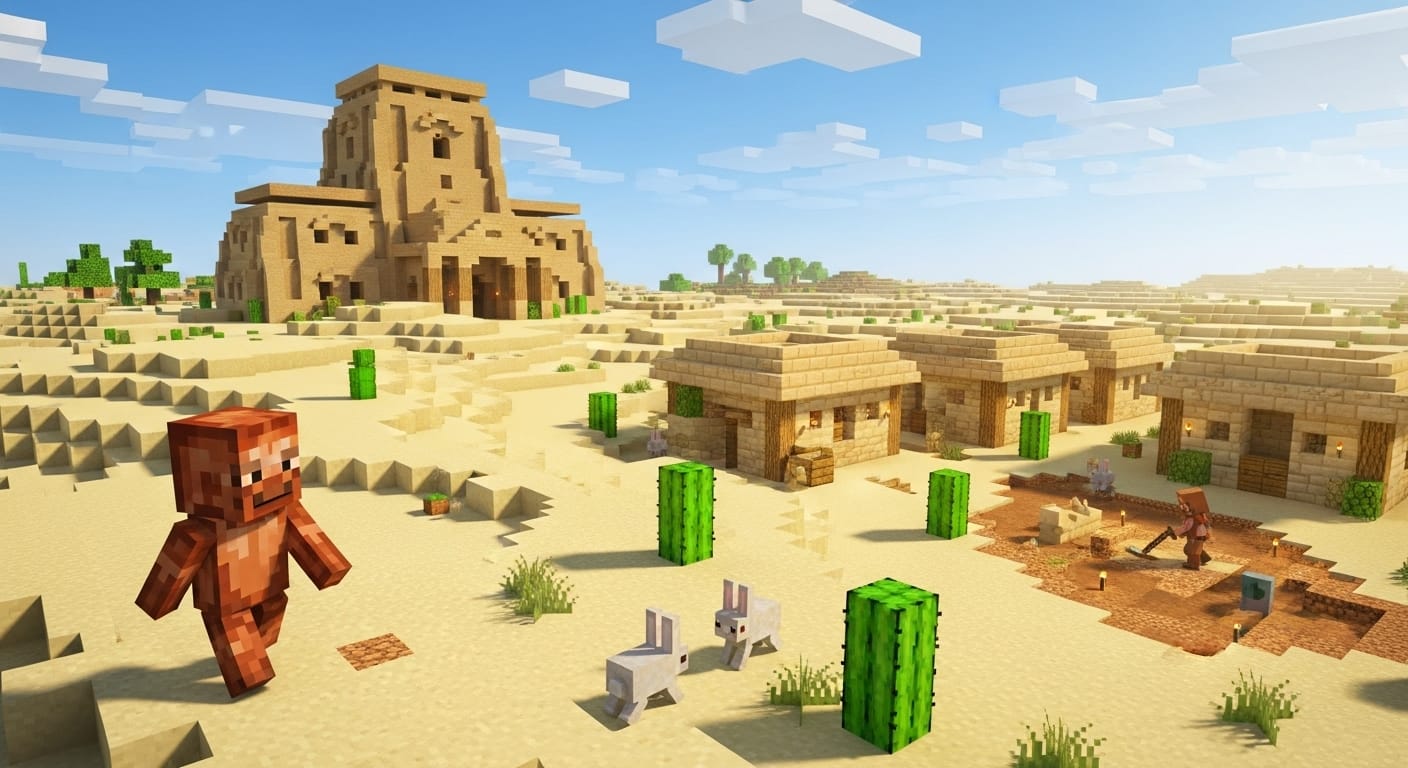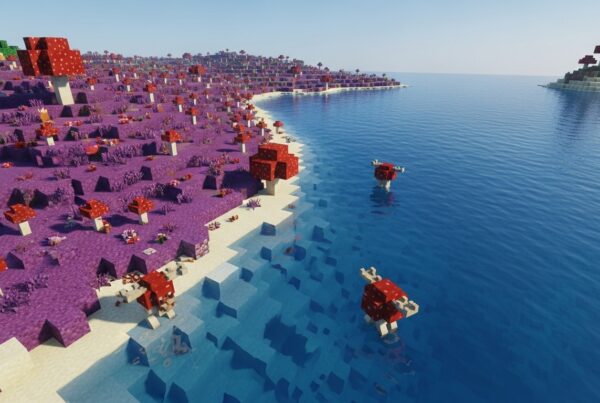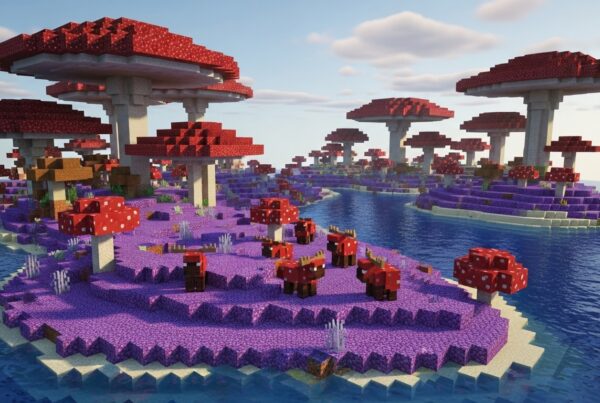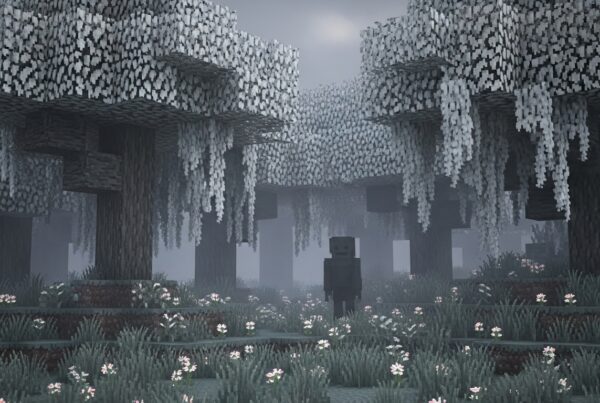The Desert Biome in Minecraft is one of the most recognizable and unforgiving environments in the game. With scorching heat, no rainfall, and endless dunes of sand, it challenges players to adapt their survival strategy. Yet beneath its harsh conditions lie incredible rewards — hidden temples, valuable loot, and ideal terrain for creative builds. Whether you’re exploring for treasure or planning a massive base, mastering the desert means learning to thrive in scarcity.
Biome Overview
Location & Climate
- Found in warm regions of the Overworld, often bordering Savanna or Badlands biomes.
- The desert has a temperature value of 2.0 and no rainfall, meaning no snow or thunderstorms ever occur here.
- Water sources are rare, but nearby rivers or oases can provide valuable hydration points.
Terrain & Appearance
- Mostly flat and open, with sand dunes, sandstone formations, and occasional water pools.
- Composed of sand, sandstone, and smooth sandstone blocks.
- Ideal terrain for building, mining sand, or creating efficient redstone farms.
Variants & Generation
- Desert Hills and Desert Lakes were once separate biomes but no longer generate naturally in recent updates.
- Some older worlds may still contain these legacy variants.
- In the latest versions, desert generation includes fossils, desert temples, villages, and now archaeology sites.
Flora and Fauna
Despite its barren appearance, the desert sustains a few hardy life forms.
Plants
- Cactus: Naturally grows up to three blocks tall; used for green dye, XP farms, and traps.
- Dead Bushes: Drop sticks when broken — a crucial early resource when wood is scarce.
Animals
- Rabbits: The only passive mob found in deserts. Their beige or cream color helps them blend into the environment. Drops include rabbit hide, raw rabbit, and rabbit’s foot (used for potions).
💡 Tip: Carry a shovel enchanted with Looting to maximize rabbit drops for food and potions.
Mobs Found in the Desert
Hostile Mobs
At night, the desert becomes one of Minecraft’s most dangerous places.
- Husks: Desert-exclusive zombies that don’t burn in daylight and inflict Hunger when attacking.
- Skeletons, Spiders, Creepers: Common nighttime threats.
- Endermen: Occasionally spawn, especially on flat terrain.
- Pillagers: Can spawn near Pillager Outposts, which sometimes generate in desert regions.
Passive Mobs
- Rabbits (beige or gold variants).
| Mob Type | Spawning Time | Unique Trait |
|---|---|---|
| Husk | Night & Shade | Doesn’t burn in sunlight |
| Skeleton | Night | Shoots arrows |
| Enderman | Night | Teleports when attacked |
| Rabbit | Day | Passive mob, food source |
💡 Survival Tip: Husks spawn more frequently than normal zombies in deserts, replacing most of their spawn rate. Always carry armor or shields to reduce Hunger effect damage.
Structures and Points of Interest
The Desert Biome may seem empty, but it’s home to some of Minecraft’s most loot-rich and historically themed structures.
Desert Villages
- Made of sandstone and terracotta, blending naturally into the landscape.
- Villagers wear light-colored robes and trade for valuable early resources.
- Often located near desert wells or small oases, providing a safe haven.
Desert Temples (Pyramids)
- Contain four hidden chests with loot such as diamonds, emeralds, enchanted books, and horse armor.
- Beneath the floor lies a TNT trap triggered by a pressure plate.
- How to Disarm Safely: Break the blue terracotta block and dig around the central shaft — never step on the pressure plate.
Desert Wells
- Rare, small sandstone wells with a single water source block.
- Now relevant in Minecraft’s Archaeology update, as suspicious sand can generate nearby, containing pottery shards and rare finds.
Pillager Outposts
- Occasionally spawn in desert biomes, often accompanied by patrols.
- Provide crossbows, banners, and iron loot, but are guarded by multiple pillagers.
Fossils
- Found underground, composed of bone blocks and sometimes coal ore.
- Useful for decorative builds or large-scale bone meal production.
Archaeology Features (1.20+)
- Suspicious Sand spawns around Desert Temples and Desert Wells.
- Use a brush to uncover ancient artifacts such as pottery shards or emeralds.
Resources and Materials
| Resource | Where Found | Use |
|---|---|---|
| Sand | Surface | Glass, TNT, concrete powder |
| Sandstone | Beneath sand layers | Building material |
| Cactus | Surface | Green dye, mob farms |
| Dead Bush | Surface | Sticks |
| Rabbit Drops | Hunting rabbits | Food, potions |
| Pottery Shards | Archaeology dig sites | Craft decorative pots |
💡 Pro Tip: Bring Shovels with Efficiency and Silk Touch for large-scale sand mining.
Survival Strategies
Early Game Checklist
- Collect sticks from dead bushes.
- Locate a village — your best source of food and shelter.
- Mine stone below the surface for tools.
- Trade with villagers to get bread, carrots, and armor.
- Avoid exploring at night until properly equipped.
Building and Shelter
- Construct bases from sandstone or smooth sandstone to blend with the landscape.
- Build partially underground to avoid mob attacks and keep cool during the day.
- Avoid excessive use of sand in structures — it falls and collapses easily.
Water and Farming
- Bring buckets or locate rivers before venturing too far.
- Crops can grow in deserts if placed near a water source block.
- Villages often have irrigated crop plots — expand them to sustain your food supply.
Combat and Navigation
- Always carry a shield to block arrows from skeletons.
- Mark your routes with torches or banners; the desert’s uniform terrain makes it easy to lose your bearings.
- Use wells or pillager outposts as landmarks when exploring.
Best Uses of the Desert Biome
- Sand Mining Hub: Harvest sand for glass, concrete, and TNT.
- Mob Farms: The flat terrain makes it ideal for efficient spawning platforms.
- Architectural Builds: Perfect for temples, pyramids, or ancient ruins.
- Archaeology Sites: Dig for pottery shards and rare artifacts.
- Technical Builds: Redstone contraptions perform smoothly thanks to minimal vegetation.
Java vs. Bedrock Edition Notes
- Husks spawn more frequently in Java Edition.
- Desert Temples and Wells generate slightly differently between versions.
- Archaeology content (Suspicious Sand and Pottery Shards) available in Minecraft 1.20+ for both editions.
- Villager trading options and professions can differ slightly between versions.
Fun Facts
- Deserts never experience rain or thunderstorms, even during world events.
- Cactus blocks damage any entity that touches them.
- Some desert structures generate aligned with chunk borders, useful for technical players.
- Rabbits in deserts are the only source of rabbit hide in hot biomes.
FAQ
Q: Can crops grow in the desert biome?
A: Yes, as long as the farmland is hydrated by a nearby water source block or irrigation from a village farm.
Q: How can I find a desert temple easily?
A: Temples often spawn near the center of large desert regions — traveling along biome borders increases your chances.
Q: Are there trees in the desert biome?
A: No. Wood must be imported or obtained by trading with villagers.
Q: What’s inside suspicious sand?
A: Pottery shards, emeralds, and rare loot can be uncovered using a brush from archaeology sites.
Q: Do husks burn in sunlight?
A: No. Husks are unique zombie variants that remain active during the day.
Conclusion
The Minecraft Desert Biome is a realm of extremes — resource scarcity, relentless mobs, and scorching landscapes. Yet with preparation and strategy, it becomes one of the most rewarding places to explore. From uncovering ancient relics in suspicious sand to building massive sandstone structures, the desert offers endless adventure for explorers and builders alike.
Mastering its challenges isn’t about enduring the heat — it’s about discovering the hidden stories buried beneath the sand.






